Host: Fraser Cain (@fcain)
Guests: Morgan Rehnberg (cosmicchatter.org / @cosmic_chatter), Nancy Atkinson (@Nancy_A)
Continue reading “Weekly Space Hangout – May 2, 2014: Gas Clouds & Photobombs”
Virtual Star Party – April 26, 2014- Hangoutathon Special Edition!
This week’s Virtual Star Party was a special 2-hour Saturday night version recorded as part of the Cosmoquest Hangoutathon. The Star Party at this link starts at 1 hour in – we’ll get an edited version up soon!
Continue reading “Virtual Star Party – April 26, 2014- Hangoutathon Special Edition!”
Where Is the Center of the Universe?
In a previous episode we hinted that every spot is at the center of the Universe. But why? It turns out, every way you look at it, you’re standing dead center at the middle of everything. And so is everyone else.
We ended a previous episode with how the center of the Universe is everywhere, and then quickly moved on to “Thanks for watching” without providing any details other than a wink and a nod.
Good news, here come your details. First, imagine the expanding Universe in your mind. You might be picturing an inflating ball pushing out in all directions. Perhaps you’re seeing some kind of giant expanding celestial pumpkin. Unfortunately, that idea is incorrect. But don’t feel bad, our thinking meat parts just aren’t built to do this sort of thing.
The region of space that we can see is the observable Universe. When we look in any direction, we’re seeing the light that left stars millions and even billions of years ago. When you get out to the 13.8 billion light year mile marker, you’re seeing the light that was emitted shortly after the Big Bang, when the Universe cooled down to the point that it became transparent. So the observable Universe is a sphere around you, it’s relative to your position.
My observable Universe is a sphere around me, relative to my position. So if I’m 10 meters away from you, I can see a little further into the Universe in that direction. If you look behind you, you’re seeing the observable Universe a little further in the that direction.
Imagine you’re standing in a dark room holding a candle. You can see out into a sphere around you. You’re at the center of your observable space. And if I’m in a different location, I’ll have a different observable sphere. This is why we say that everyone is at the center of their own personal observable Universe.
This has hints of pedantry and it’s a little unsatisfying, so let’s dig a little deeper. Where is the actual center of the Universe, regardless of who’s observing it? Our Universe might be finite or it might be infinite. Astronomers don’t actually know for sure. Their most precise calculations say that the observable Universe is 93 billion light years across.

Remember that light from the Big Bang that took 13.8 billion light years to get to you? Well the expansion of the Universe has pushed that region out to more than 46 billion light-years away. Look as far as you can to the right and as far as you can to the left. Those two spots are currently 93 billion light-years away from each other. So we can’t see how big the Universe really is. It’s got to be larger than 93 billion light-years. Everything outside that region we just can’t see… yet. It might be infinite.
If the Universe is infinite, then there’s an infinite amount of space in that direction and an infinite amount of space in that direction, and that direction. And we’re back where we started, literally. Once again, you’re at the center of the Universe. And so am I.
But what if the Universe is finite? That’s where it gets tricky. Imagine the observable Universe as a tiny sphere inside the much larger actual Universe. Maybe it’s 100 billion light years across, or maybe a trillion, or a quadrillion. Whatever the size, it’s not infinite. Now you would think there’s a center, right?
Well, astronomers think that the topology of a finite Universe indicates that if you travel in any one direction long enough, you’ll return to your starting point. In other words, if you could look far enough in any direction, you’d see the back of your head.

We did a whole episode on this, and you might want to check it out. And you’ll really want to check out Zogg the Aliens’ in-depth explanation. As an analogy, consider an ant on the surface of a sphere. Should the ant choose to walk in any direction, it’ll return to its starting point. Take that concept and scale it up one dimension. Can’t imagine it? No problem. Like I said, our brains aren’t equipped or experienced. And yet, that extra dimension seems to be the nature of the Universe. Regardless of what direction you travel, if it takes you the same amount of time to return to your starting point. Well… you’re at the center of the Universe?
See? No matter how you think about it and break it down, you’re at the center of everything. And so am I. What do you think? Is the Universe finite or infinite? Tell us why in the comments below.
Weekly Space Hangout – April 25, 2014: Asteroids, ISS Repairs & an Annular Eclipse
Host: Fraser Cain
Guests: Morgan Rehnberg, Brian Koberlein, David Dickinson, Jason Major
This Week’s Stories:
Morgan Rehnberg (cosmicchatter.org / @cosmic_chatter):
EVA
Cosmos
SpaceX announcements
Brian Koberlein (@briankoberlein, briankoberlein.com):
Meteors are not more likely to hit Earth
Dave Dickinson (@astroguyz, www.astroguyz.com):
Saturn at Opposition
Bizarre Annular Eclipse
Jason Major (@JPMajor, LightsInTheDark.com):
B612 Foundation asteroid announcement
We record the Weekly Space Hangout every Friday at 12:00 pm Pacific / 3:00 pm Eastern. You can watch us live on Google+, Universe Today, or the Universe Today YouTube page.
Weekly Space Hangout – April 18, 2014: Another Earth, Dragon Launch, LADEE Impact
Host: Fraser Cain
Guests: Casey Dreier, Brian Koberlein, Jason Major, Sondy Springmann, David Dickinson
Continue reading “Weekly Space Hangout – April 18, 2014: Another Earth, Dragon Launch, LADEE Impact”
How Do We Know the Moon Landing Isn’t Fake?
There’s a conspiracy theory that astronauts never landed on the Moon. Is it all a conspiracy? Were the Moon landings faked? What is the evidence that we actually went to the Moon?
Apparently, there’s an organization called “NASA”, who’s done a remarkable job of sticking to their story. They say Neil Armstrong and Buzz Aldrin landed on the Moon on July 20, 1969, and set foot on the surface 6 hours later.This same organization claims there were 5 additional missions which successfully landed on the Moon, and an alleged total of 12 people went for a walk there.
Can you imagine? According to them, they spent $24 billion, which is more than $150 billion in inflation adjusted dollars. Their so-called “Apollo” program allegedly employed 400,000 people, supported by more than 20,000 companies and research institutions. I say “alleged”, as some people choose to think the Moon landings were acts of cinematic chicanery.
More than 10 years ago, Fox popularized the Moon landing conspiracy with a show called “Did We Land On The Moon?”. They revealed several pieces of evidence about the hoax and cover-up citing incorrect shadows on the Moon, lack of background stars, and more. Each of the pieces of evidence they present is wrong and easily explained once you understand the underlying science.… Or at least, that’s what they would have us believe.
Phil Plait successfully brings a NASA supporting voice to this story, explaining how the evidence against moon landings is at best, fantasy and misunderstanding. A more cynical view might be to suggest it’s a deliberate manipulation created to maintain an anti-scientific narrative to foster ignorance, mistrust and uphold a larger political agenda. Do a little search for “Phil Plait moon landing” and you’ll see him present even-handed science over any one of the arguments. In fact, if you buy into that whole “evidence” idea, he appears to successfully tear apart the conspiracy arguments.
Some still, are not convinced, possibly including you. “NASA and Phil, they’re in cahoots. Phil’s a PhD astronomer, which means he studies space, one of the letters in NASA stands for SPACE, I think it’s the A.” Coincidence? I think not. There’s collusion going on there.
The main pillar of any conspiracy requires a few select people keeping a really, really, really big secret. Looking at the numbers, the select group required to successfully fabricate the appearance of hurling metal capsules containing humans at our orbiting neighbor and then retrieving them, additionally keep their story straight for at best 45 years, and never, ever slip up… is about 400,000 humans.
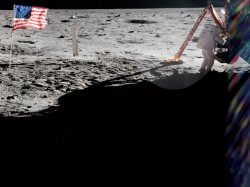
So, there are really two sides to this story, the NASA side which is… They went to the Moon. and everyone is telling the truth. OR, they never went to the Moon, and somehow 400,000 people have never, ever, ever, ever let it slip that they made a bunch of fake moon rocks, or the rockets shot up didn’t really go anywhere. It’s all a big ruse. The thought 400,000 people have managed to keep their mouths shut is definitely the more romantic perspective. Seeing people come together to screw with everyone, and then never blabbing. This truly is a triumph of the human spirit.
When something big does happen, like the Chelyabinsk meteor, we see the evidence everywhere – for example captured on Russian dashboard cameras. For the lunar landing, NASA suggests something similar. There are independent astronomers who tracked the rockets escape from Earth’s gravity, and are either providing unsolicited, nonpartisan unfunded support of the events, or they’re in on the whole thing. The Russians, who were in a race with the Americans to be the first to set foot on the Moon, allegedly tracked the missions in horror and disappointment.
NASA just keeps sticking to this story that they sent people to the moon. In fact, they just keep on producing more of their “evidence”. They recently published high resolution images of the surface of the Moon captured by their own Lunar Reconnaissance Orbiter. Adding a whole new generation of secret keepers, who now know the secret handshake and get participate in the rigging of Oscar nights.
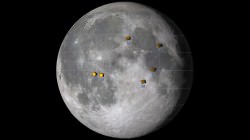
They imaged all of the alleged Apollo landing sites, and they haven’t missed any detail. You can see the landers, rovers, and even the astronauts’ footsteps. The images show that all the flags planted are still standing, except Apollo 11, which was blown over by the exhaust from the ascent engine. Or alleged exhaust from an alleged ascent engine, if you’re still thinking 400,000 people are continuing to punk the triumphs of mankind. Some might suggest that a big paycheck was sent on over to China and Japan, to have them verify the landing sites by photographing them with their own spacecraft.
According to NASA the astronauts placed retro-reflectors during their missions which reflect light directly back to Earth. Apparently these can be used this to calculate the distance to the Moon with 1 cm accuracy. So, if you want to confirm that humans went to the Moon for yourself, you could just point a high-power laser at the landing sites. Sure, there are many large independent institutions which have verified the existence of these retro-reflectors, but who knows, maybe they’re some how pawns of our silent and vigilant 400,000 co-conspirators.
What do you think? Make up a conspiracy theory for your favorite triumph of human innovation and exploration! Post it in the comments below.
Weekly Space Hangout – April 11, 2014: Exomoons, Eclipses & Launches
Host: Fraser Cain
Astrojournalist: Morgan Rehnberg(cosmicchatter.org / @cosmic_chatter)
Continue reading “Weekly Space Hangout – April 11, 2014: Exomoons, Eclipses & Launches”
Can Tatooine Be Real?
We’re familiar with the sky on Tatooine with its twin suns. But could a planet actually orbit two stars at the same time? Could you have a planet in a multiple star system with 4, 6 or more suns?
Hey kids, you remember Star Wars right? Tatooine ring any bells? Lots of sand Tusken raiders walking single file. Banthas sweating all over the place like some crazy mammoth-goat breeding experiment gone horribly awry?
Tatooine was an arid desert planet, it had 2 suns and 3 moons. It’s not the only fictional planet to orbit multiple suns. In Nightfall by Isaac Asimov, planet Lagash had 6 suns. Could something like this be possible?
Interestingly, most stars in the Milky Way are in multiple star systems. You can easily have double, triple, or quadruple systems. There are even star clusters with hundreds or even thousands of stars. Just imagine the crazy chaotic gravitational interactions in a multiple star system.
So, could they have planets? Yes. There are circumbinary systems, where stars orbit each other their planets orbit outside, circling them both. Since the stars orbit one another so closely, it’s the gravitational equivalent of a single star. From an orbiting planet, the stars would always appear together in the sky.
To date, we have discovered 17 of these systems. Then there are wide binary systems, which are far more dangerous for planets. Here the planets orbit one main star, and there’s another star which maintains a distant orbit much further out. You don’t want to live there. The gravitational interactions are chaotic and lead to mayhem. In simulations, planets which aren’t tightly orbiting a star are ejected out of the system, or crashed into other planets or stars.
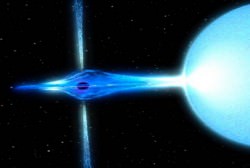
We might already be detecting highly elliptical orbits from disrupted planets just like these. A triple star system was recently discovered in the constellation Cygnus: HD 188753. Here, a pair of stars are tightly bound, and these are in a wide binary arrangement with a sun-mass star. A planet closely orbits the primary star, but all other planets were likely ejected.
In the year 2012, a planet was found around Alpha Centauri B, and PH1 was the first quadruple star system to be discovered to have a planet. Kepler 47 is a multi-star, multi-planet system. Two stars orbit one another every 7.45 days. Here, the gas giant Kepler 47c orbits the stars every 303 days and is even located in the habitable zone. This sounds like perfect concept art for a Vin Diesel film, or artwork airbrushed on the side of a van.
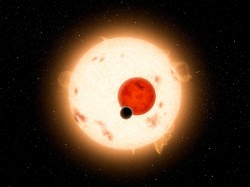
Finally, In 2011, the Kepler-16 system was found to have a circumbinary planet in the habitable zone. So, two stars, closely orbiting each other and a Saturn-mass, Kepler 16b orbiting the two. Astronomers informally called this a real Tatooine.
What do you think? Would you want to live on a desert world like Tatooine or Arrakis? Tell us your thoughts in the comments below.
Astronomy Cast Ep. 342: Sunsetting Spacecraft
Everything dies, including our technology. But when we’ve hurtled a few thousands pounds of robotic instrumentation to another planet, it gets a little difficult to shut it down and clean up. What do we do when a mission has reached the end of its useful life?
Continue reading “Astronomy Cast Ep. 342: Sunsetting Spacecraft”
Can You Escape the Force of Gravity?
It feels like you just can’t get away from clingy gravity. Even separated by distances of hundreds of millions of light years, gravity is reaching out to all of us. Is there a place you could go to get away from gravity entirely?
Fortunately for our space intolerant tissues and terrible oxygen dependency withdrawal symptoms, gravity binds us to our sweet, cozy home with breathable air, the Earth. Its collective mass is trying to accelerate you towards its center, that way, at 9.8 meters per second squared. But the Earth isn’t the only one looking to cuddle.
You’re also being pulled at by the Moon, and if it weren’t for the Earth here, that pull could hurl you far off into deep space, or crash you into its cold dusty surface. In fact, as the Moon passes overhead, you’re being imperceptibly tugged upwards. This possessive tug o war isn’t just between the moon, and the earth fighting over you like an older brother keeping a small doll out of reach a younger sibling.
The Sun is also in on this shenanigan. Gravity from there is pulling at you from a distance of 150 million km. Well, aren’t we popular. So how far would you have to go to escape this gravitational custody battle completely?
Even At 2.5 million light years distance, gravity is still reaching out and being a clingy creeper. The Milky Way and Andromeda are pulling towards each other. The gravity between these two bodies is strong enough to overcome the expansion of the universe. Which will result in a galactic smash-up derby a few billion years from now.
There’s no end to it. Gravity appears to be madly greedy and long armed. Members of the Virgo Super cluster are connected to each other, and they’re dozens of millions of light-years apart. Objects in the Pisces-Cetus Super cluster complex are even connected to each other by our invisible and obnoxiously possessive friend. And they are hundreds of millions of light years apart…
In fact, you’re so popular that you are gravitationally pulled towards even most distant object in the observable Universe. And they, in turn, are linked to you. As a result, without the outward expansion and acceleration of the Universe, everything would fall inward to a common center of gravity. Newton thought that gravity was instantaneous and if the Sun disappeared, the Earth would immediately fly away. Einstein realized that gravity is distortions of spacetime caused by mass. And as it turns out, gravity moves at the speed of light.
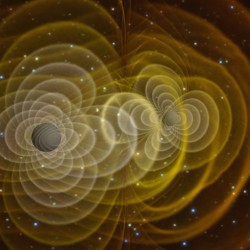
If the Sun disappeared, Earth would continue to follow the curved spacetime distortion for 8 whole minutes. Interactions between massive objects, like when black holes collide, cause ripples in spacetime called gravitational waves. As a gravitational wave passes through, you get warped in spacetime, like a wave in the water. The amount is so slight we’ve never seen them directly. However, the decay of pulsar orbits have shown them indirectly.
The ground-based LIGO experiment might someday detect a gravitational wave, but there’s been no luck so far. The Space-based LISA experiment should detect gravitational waves with more precision. The first version will launch in 2015, but the real experiment probably won’t be operational until 2030.
Everybody wants a piece, and I don’t know about you, I just want to be left alone. Gravity’s is reach is amazingly far. It’s everywhere, all the time, and it’s having none of that. What do you think? If you had the power to remove yourself from Gravity’s pull, what would you do? Tell us in the comments below.




